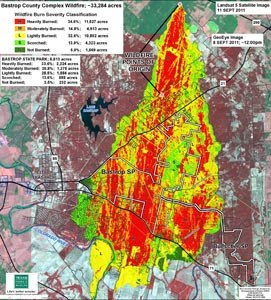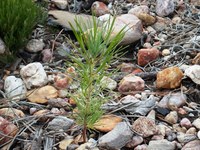Life After Wildfire
 The Bastrop County Complex fire was the most destructive wildfire in state history. The 32,000-acre inferno ignited on Sept. 4, 2011, and burned for 55 days, destroying over 1,600 homes and killing two people.
The Bastrop County Complex fire was the most destructive wildfire in state history. The 32,000-acre inferno ignited on Sept. 4, 2011, and burned for 55 days, destroying over 1,600 homes and killing two people.
Lost Pines Ablaze

- Fire repeatedly threatened the park's CCC structures. Preparation and quick thinking by firefighters saved them.
High winds on Sept. 4, 2011 directed fire quickly into Bastrop State Park, a National Historic Landmark with structures built by the Civilian Conservation Corps (CCC), Works Progress Administration (WPA), and National Youth Administration (NYA) during the Great Depression in the 1930s.
Hundreds of defenders, including more than 140 TPWD wildland firefighters, TPWD staff, and commercial partners, battled the blaze. In the end, fire impacted 96 percent of the 6,565-acre park.
Most notably, the fire significantly impacted the Lost Pines ecosystem, an area of isolated loblolly pines that is home to the endangered Houston toad.
Long Road to Recovery
It will take a generation or more for the Lost Pines to recover from this catastrophic wildfire. Despite this, the park is already showing new growth!
In some areas, tiny loblolly pines dot the forest floor. Some pines are already taller than the average hiker! Shrubs like yaupon and American beautyberry are once again producing food for wildlife. Animals large and small are making homes throughout the park.
Although nature is regenerating some on its own, much work remains. Cleanup of the park is complete - now we look toward the future of the Lost Pines ecosystem.
Erosion
Erosion continues to be one of the biggest issues. Chunks of hillside are still sloughing off in heavy rains and even light rains sweep soil away. Without stable ground and fertile soil, plants cannot take root.
One of the first steps to reforestation is to stop erosion in the park. One way we accomplish this is by applying hydromulch – a slurry made of native grass seed, straw, and water. We sprayed hydromulch in regions of the park especially in need of assistance.
Other efforts include re-routing trails along more sustainable paths. This long process has led to the creation of new trails in the future vision of the park.
Replanting
 Replanting the special "drought-hardy" loblolly pines genetically unique to this region began in the park and county in January 2013. Over five years, volunteers and contractors planted 2 million loblolly pine trees in the park. Volunteers from around the world planted 140,686 loblolly pine seedlings!
Replanting the special "drought-hardy" loblolly pines genetically unique to this region began in the park and county in January 2013. Over five years, volunteers and contractors planted 2 million loblolly pine trees in the park. Volunteers from around the world planted 140,686 loblolly pine seedlings!
We will continue to use contracted labor to plant tiny seedlings to create a mosaic of tree ages as the forest grows.
Prescribed fire
Prior to the wildfire, park staff used prescribed fire to manage the park's landscape. In the fall of 2014, we began using prescribed fire again.
The drought- and fire-killed trees will eventually fall and provide fuel on the ground, which increases wildfire danger. Low-intensity prescribed fire will clear out the dead fuel, keep the growth of oak trees in check, and allow a new pine forest to flourish.
Learn more about the use and benefits of prescribed fire.
Houston Toad
The Houston toad is an endangered species whose last stronghold was in Bastrop State Park. The toad suffered in the wake of the wildfire and drought. These amphibians require a habitat with plenty of tree canopy, so only time can restore their home.
Through strong partnerships with local landowners, the U.S. Fish and Wildlife Service, and the Houston Zoo, we continue to monitor and restore habitat. In July 2017, the U.S. Fish and Wildlife Service and TPWD finalized a programmatic Safe Harbor Agreement for the Houston toad. The agreement encourages interested landowners to undertake conservation actions to assist in the species' recovery throughout its range.
How You Can Help
Visit
Reserve a campsite, take a hike or sleep in a cabin. Over the next several decades, visitors have the unique opportunity to witness the rebirth of a pine forest. Each time you visit, you will see something new.
Volunteer

- Members of American Youth Works' Environmental Corps have created trails, built bridges and supervised volunteers.
Volunteer your time or donate specialty items for both short- and long-term restoration and stewardship of the park. Email the Lost Pines Complex volunteer coordinator or call (512) 718-0211.
Donate
Friends of Lost Pines State Parks is an independent 501(c)3 nonprofit fundraising and service group organized to help promote, interpret and operate Bastrop and Buescher state parks. Visit the Friends of Lost Pines State Parks Facebook page or call the park for more information.
Related Information
- News releases:
- "Bastrop State Park Back in Full Swing Post-Wildfire" (April 9, 2012)
- "Burned Aeration System at Bastrop State Park Replaced Through Vertex Donation" (Oct. 26, 2011)
- "Bastrop State Park Opening Pushed Back" (Oct. 6, 2011)
- “Lost Pines' Experience Lives on at Buescher State Park" (Sept. 22, 2011)

